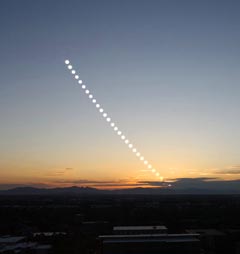
Multiple-exposure photo of the setting sun, showing that it follows the same diagonal path that a star would, as seen from a mid-northern latitude. This photo was made on June 21, when the sun set considerably north of due west.
To those of us who live on earth, the most important astronomical object by far is the sun. It provides light and warmth. Its motions through our sky cause day and night, the passage of the seasons, and earth's varied climates.

Multiple-exposure photo of the setting sun, showing that it follows the same diagonal path that a star would, as seen from a mid-northern latitude. This photo was made on June 21, when the sun set considerably north of due west.
On any given day, the sun moves through our sky in the same way as a star. It rises somewhere along the eastern horizon and sets somewhere in the west. If you live at a mid-northern latitude (most of North America, Europe, Asia, and northern Africa), you always see the noon sun somewhere in the southern sky.
But as the weeks and months pass, you'll notice that the sun's motion isn't quite the same as that of any star. For one thing, the sun takes a full 24 hours to make a complete circle around the celestial sphere, instead of just 23 hours, 56 minutes. For obvious reasons, we define our day based on the motion of the sun, not the stars.
Moreover, the location of the sun's path across the sky varies with the seasons, as shown in the computer-generated image below, which shows the eastern sky, viewed from a mid-northern latitude.
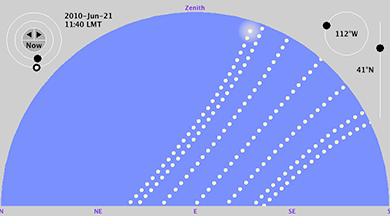
This simulated multiple-exposure image shows the path of the rising sun through the eastern sky on the morning of the 21st of each month, from December at the right through June at the left. The latitude was set to 41° north. (The spreading of the trails as they go upward is a distortion caused by stretching the domed sky onto a flat semicircle.)
The sun's path through the rest of the sky is similarly farther north in June and farther south in December. In summary:
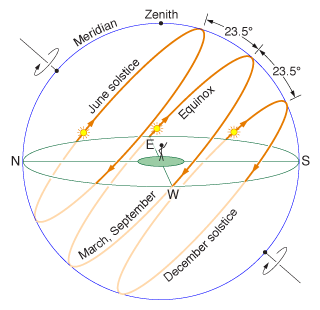
The sun appears to move along with the celestial sphere on any given day, but follows different circles at different times of the year: most northerly at the June solstice and most southerly at the December solstice. At the equinoxes, the sun's path follows the celestial equator.
The illustration shows three of the sun's daily paths around the celestial sphere, again as seen by an observer at latitude 41° north. At the equinoxes, exactly half of the sun's circular path lies above the horizon. But notice that in June, considerably more than half of the circle is above the horizon, while in December, much less than half the circle is visible. This is why, if you live in the north, you have more hours of daylight in June (during your summer) than in December (during your winter).
Question: If your latitude is 41° north, what is the angle (in degrees) between the noon sun and your southern horizon at the March or September equinox?
The added hours of daylight are one reason why summer is warmer than winter. But there's another reason that's even more important: the angle of the mid-day sun. Notice from the illustrations above that the noon sun is much higher in June than in December. This means that the sun's rays strike the ground more directly in June. In December, on the other hand, the same amount of energy is diluted over a larger area of ground:
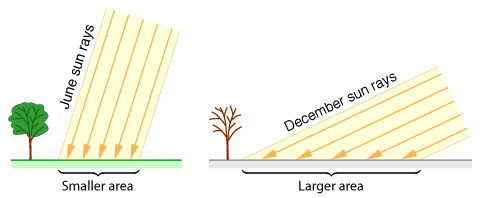
The intensity of sunlight striking the ground depends on the sun's angle in the sky. When the sun is at a lower angle, the same amount of energy is spread over a larger area of ground, so the ground is heated less. The angles shown here are for the noon sun at latitude 41° north.
There is a common misconception that summer is warmer than winter because the sun is closer to us in the summer. Actually the sun's distance hardly changes at all—and in fact, the sun happens to be closest to us in January. Again, the seasonal changes in climate are caused by the varying angle of the sun's rays, together with the varying amount of time that the sun is above our horizon.
Although we never see the sun and the stars at the same time, it's not especially hard to figure out which stars and constellations the sun is lined up with on any given day: Just look at the constellations in the east a little before sunrise, or the constellations in the west a little after sunset, and allow for the angle of the sun below your horizon.
The ecliptic is a great circle on the celestial sphere, tipped 23.5° with respect to the celestial equator. Its orientation with respect to our horizon changes as the sphere spins around us each day. It has the orientation shown here at noon in December and at midnight in June.
If you plot the sun's daily location on a star chart or celestial globe, you'll find that it gradually traces out a great circle, called the ecliptic. So the ecliptic is an imaginary circle around the celestial sphere, centered on us, that marks all the possible locations of the sun with respect to the constellations. Each day, as the sun takes four minutes longer than the constellations to spin around us, it creeps approximately one degree eastward along the ecliptic. It completes the circle in exactly one full year (365.24 days).
The ecliptic intersects the celestial equator at two opposite points, the sun's locations at the equinoxes. But the ecliptic is tipped at a 23.5° angle with respect to the celestial equator, so half of it is in the celestial sphere's northern hemisphere and half is in the south. The sun reaches the ecliptic's northernmost point at the June solstice, and reaches its southernmost point at the December solstice.
The constellations of the zodiac are simply those that happen to lie along the ecliptic. Traditionally there are 12 of them: Pisces, Ares, Taurus, Gemini, Cancer, Leo, Virgo, Libra, Scorpius, Saggitarius, Capricornus, and Aquarius. According to the modern official constellation boundaries, however, most of the Scorpius portion of the ecliptic actually lies in the adjacent constellation Ophiuchus.
In this 360-degree map of the entire celestial sphere, the north celestial pole is stretched across the top edge and the south celestial pole across the bottom edge. The celestial equator is marked in blue, and the 12 constellations of the zodiac are outlined. The ecliptic, shown in yellow, marks the sun's annual path among the stars. At the March equinox the sun is at the far right, in Pisces. The sun drifts leftward by about one degree per day, moving first into the northern half of the sky and then, after the September equinox, into the southern half.
The sun's location with respect to the stars doesn't depend on your observing location on earth, so you now know enough to figure out how the sun appears to move through the sky from other locations.
If you travel east or west, you'll see the sun rise and set earlier or later, respectively, just like a star would. Again, we partially compensate for this by setting our clocks to different time zones.
If you travel north or south, the sun's daily motion is still the same as that of a star seen from your latitude. So at the equinoxes, for example, the sun still follows the celestial equator, while at the solstices, the sun follows a circle that lies 23.5° north (in June) or south (in December) of the celestial equator. If you can visualize the paths of stars on these parts of the celestial sphere, then you can visualize the daily path of the sun.
So, for example, as you travel northward from Utah, you'll see the noon sun get lower and lower in the southern sky. Eventually you'll come to a latitude where the noon sun at the December solstice lies on your southern horizon; this latitude, 23.5° below the North Pole, is called the Arctic Circle. North of the Arctic Circle there will be days around the December solstice when the sun never rises. What's a little less obvious is that at the Arctic Circle on the June solstice, the sun never sets—it merely grazes the northern horizon at midnight (see the illustration below). Still farther north there will be more and more days of darkness in winter and continuous sunlight in summer. At the North Pole, the sun is above the horizon for six straight months (March through September), spinning around in horizontal circles, reaching a maximum height of 23.5° above the horizon at the June solstice.
As you travel southward in the northern hemisphere, the noon sun gets higher and higher. The first qualitative change occurs at 23.5° latitude, where the noon sun on the June solstice passes directly overhead. This latitude is called the Tropic of Cancer. Farther south, in the so-called tropics, the noon sun will appear in the northern sky for a period of time around the June solstice. At the equator, the noon sun is straight overhead on the equinoxes. And after you pass 23.5° south latitude (the Tropic of Capricorn), the noon sun is always in the north. Much farther south is the Antarctic Circle, where the sun never quite rises on the June solstice and never quite sets on the December solstice. Researchers at the South Pole have continuous daylight from September through March, and continuous night (including twilight) from March through September.
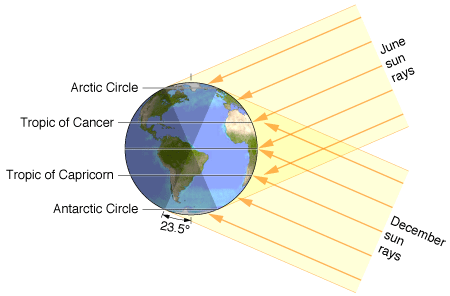
The Arctic and Antarctic Circles mark the maximum reach of the sun's rays at the solstices. The Tropics of Cancer and Capricorn mark the locations where the rays of the noon sun are perpendicular to the ground at the solstices. (Earth image adapted from NASA data using John Walker's Earth and Moon Viewer.)
These geographical variations in the sun's angle above the horizon also account for the major geographical variations in earth's climates. The arctic and antarctic regions are almost always cold—even in the summer when they get 24 hours of sunlight a day—because the sun's angle above the horizon is never very high. And the tropics are almost always warm—even though they never get much more than 12 hours of sunlight in a day—because the mid-day sun is always so high in the sky. The intermediate latitudes, which generally have hot summers and cool or cold winters, are called the temperate zones. The north temperate zone lies between the Tropic of Cancer and the Arctic Circle, while the south temperate zone (where the seasons are reversed) lies between the Tropic of Capricorn and the Antarctic Circle.
Question: If you live on the Arctic Circle, what is the maximum angle of the sun above your horizon (in degrees)?
Besides the sun's location in the sky, we can also easily measure its apparent size and the color of its light. The results might surprise you.
A simple but unsafe way to estimate the sun's apparent size is to hold up your little finger toward it. The problem is that the sun is so bright, looking directly at it can damage your eyes. Still, if you wait until the sun is greatly dimmed by clouds or haze, you can get away with a very quick glance. You'll then find that the sun's angular width is only about half that of your little finger held at arm's length—that is, only about half of a degree!
A much safer way to measure the sun's apparent size is with a homemade pinhole projector.
Because the sun is so bright, most people are surprised to learn that its angular width is only half a degree. A full circle is 360 degrees, so it would take about 720 suns, lined up side-to-side, to surround you in a full circle.
The sun's angular size doesn't depend on where in the sky we see it. A common optical illusion, however, makes the sun appear larger when it is close to our horizon. This is because we're then comparing its size to that of other distant objects on the horizon. When the sun is high in the sky, on the other hand, we normally compare its size to that of the entire sky. In any case, it's easy to check for yourself that the sun's measured angular size is always the same.
The sun's color also seems to change with its location in the sky, becoming yellow-orange, or occasionally even red, when it is close to the horizon. When the sun is high in the sky it appears essentially white—although this is hard to see because it's much harder to (safely) look at the sun at these times. But as you might guess, the variations in the sun's apparent color have nothing to do with the sun itself; the reddening near our horizon is actually caused by earth's atmosphere. Most of the air in our atmosphere is confined to a very thin shell, only a few miles thick. When the sun is high in the sky, its light therefore travels through only a few miles of air before reaching our eyes. When the sun is on the horizon, however, we see its light filtered through tens of miles of air. The sun's white light is actually a mixture of all the colors of the rainbow, from violet and blue to orange and red. The air tends to scatter the bluer colors, making the sky appear blue. The redder colors, on the other hand, are scattered much less and therefore can penetrate much farther through the atmosphere—making sunsets appear yellow-orange.
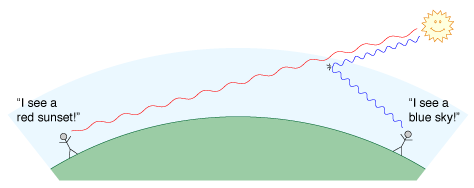
Sunlight is a mixture of all the colors of the rainbow. Air tends to scatter the bluer colors, making the sky appear blue. The redder colors can penetrate through many miles of air, causing sunsets to appear red.
Copyright ©2010-2011 Daniel V. Schroeder. Some rights reserved.